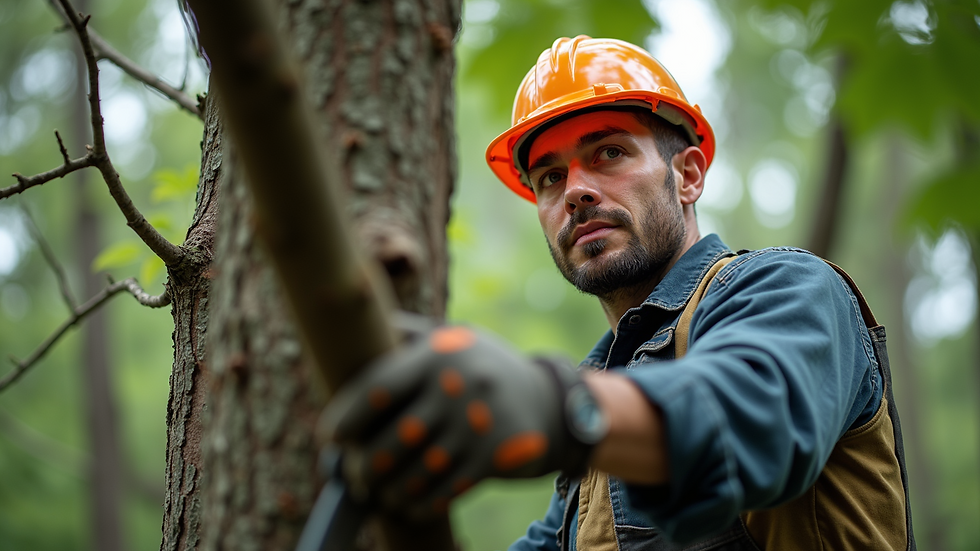Expert Tree Trimming Tips from Certified Arborist
- Ignite Fareal
- Sep 4
- 4 min read
Updated: Sep 9
Tree trimming is an essential part of maintaining the health and beauty of your trees. Whether you are a homeowner looking to enhance your landscape or a property manager responsible for maintaining green spaces, understanding the basics of tree trimming can make a significant difference. In this post, we will share expert tips from certified arborist to help you trim your trees effectively and safely.
Why Tree Trimming is Important
Tree trimming is not just about aesthetics. It plays a crucial role in the overall health of your trees. Here are some reasons why you should consider regular trimming:
Promotes Growth: Trimming encourages new growth by allowing sunlight to reach the inner branches.
Prevents Disease: Removing dead or diseased branches helps prevent the spread of illness to healthy parts of the tree.
Enhances Safety: Overgrown branches can pose a risk to people and property. Trimming reduces the chance of branches falling during storms.
Improves Appearance: A well-trimmed tree looks more attractive and can enhance the overall look of your landscape.
When to Trim Your Trees
Timing is everything when it comes to tree trimming. The best time to trim most trees is during their dormant season, which is typically late fall to early spring. Here are some specific guidelines:
Deciduous Trees: These trees lose their leaves in winter. Trim them in late winter or early spring before new growth begins.
Evergreen Trees: These trees can be trimmed in late spring or early summer. Avoid trimming in late fall, as this can stress the tree.
Flowering Trees: For trees that bloom in spring, trim them right after they flower. For those that bloom in summer, trim them in late winter or early spring.
Tools You Will Need
Having the right tools is essential for effective tree trimming. Here are some basic tools you should consider:
Pruning Shears: Ideal for small branches and delicate work.
Loppers: Great for cutting thicker branches that are too large for pruning shears.
Hand Saw: Useful for larger branches that require more power.
Chainsaw: For very large branches or trees, a chainsaw may be necessary. Always use caution and consider hiring a professional for large jobs.
Safety Gear: Don’t forget gloves, goggles, and a hard hat to protect yourself while working.
How to Trim Your Trees
Now that you have the right tools, it’s time to get started. Here are some step-by-step tips for trimming your trees:
Assess the Tree: Before you start, take a good look at the tree. Identify any dead, diseased, or damaged branches that need to be removed.
Plan Your Cuts: Decide which branches to trim. Focus on those that are crossing or rubbing against each other, as well as any that are growing inward.
Make the Cuts: Use the appropriate tool for the size of the branch. Make clean cuts at a slight angle to promote healing.
Step Back and Evaluate: After trimming, step back and look at the tree from different angles. Make sure it looks balanced and healthy.
Clean Up: Remove all cut branches and debris from the area. This helps prevent pests and diseases.
Common Mistakes to Avoid
Even experienced gardeners can make mistakes when trimming trees. Here are some common pitfalls to avoid:
Over-Trimming: Removing too much foliage can stress the tree. Always follow the one-third rule, which states that you should not remove more than one-third of the tree’s foliage in a single season.
Improper Cuts: Making flush cuts can damage the tree. Always leave a small collar of bark to help the tree heal.
Ignoring Safety: Always prioritize safety. If a branch is too high or large, consider hiring a professional arborist.
Hiring a Professional Arborist
If you are unsure about trimming your trees or if the job seems too big, hiring a certified arborist is a wise choice. Here are some benefits of working with a professional:
Expertise: Arborist have the training and experience to assess tree health and make informed decisions about trimming.
Safety: Professionals have the right equipment and knowledge to safely trim trees, especially those near power lines or structures.
Long-Term Care: An arborist can provide ongoing care and advice to keep your trees healthy for years to come.
Maintaining Your Trees After Trimming
After trimming, it is essential to care for your trees to ensure they thrive. Here are some tips for post-trimming care:
Watering: Ensure your trees receive adequate water, especially during dry spells. Deep watering encourages strong root growth.
Mulching: Apply a layer of mulch around the base of the tree. This helps retain moisture and suppress weeds.
Monitoring: Keep an eye on your trees for any signs of stress or disease. Early detection can make a big difference.
The Benefits of Regular Tree Maintenance
Regular tree maintenance, including trimming, can lead to numerous benefits. Here are a few:
Increased Property Value: Well-maintained trees can enhance the value of your property.
Improved Air Quality: Trees play a vital role in improving air quality by absorbing carbon dioxide and releasing oxygen.
Enhanced Wildlife Habitat: Healthy trees provide shelter and food for various wildlife species.
Final Thoughts on Tree Trimming
Tree trimming is an essential practice for anyone who values their landscape. By following these expert tips from certified arborist, you can ensure your trees remain healthy, safe, and beautiful. Remember, if you ever feel unsure about trimming your trees, don’t hesitate to reach out to a professional. Your trees will thank you for it.

Taking care of your trees is not just about aesthetics; it is about fostering a healthy environment for both your landscape and the wildlife that inhabits it. With the right knowledge and tools, you can make a significant impact on the health of your trees. Happy trimming!








Comments